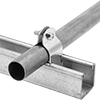Filter by
Strut Channel Type
Channel Height
Construction
Bracket Type
Strut Channel Framing Component
Thickness
Width
Weight Capacity
Export Control Classification Number (ECCN)
DFARS Specialty Metals
Building and Machinery Hardware
Material Handling
Power Transmission
Electrical






































